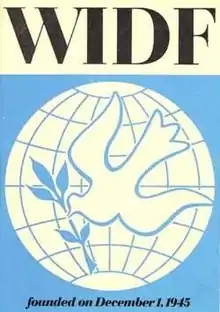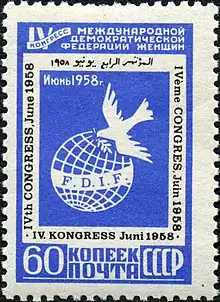Women's International Democratic Federation
Women's International Democratic Federation (WIDF) is an international organization with the stated goal of working for women's rights. It was established in 1945 and was most active during the Cold War. It initially focussed on anti-fascism, world peace, child welfare and improving the status of women.[1] During the Cold War era, it was described in recovered FBI files as Communist-leaning[2] and pro-Soviet.[3][4][5] International Day for Protection of Children, observed in many countries as Children's Day on June 1 since 1950, was established by the Federation at its November 1949 congress in Moscow.[6] The WIDF published a monthly magazine, Women of the Whole World, in English, French, Spanish, German, and Russian, with occasional issues in Arabic.[7]
 Original WIDF logo from its founding | |
| Abbreviation | WIDF |
|---|---|
| Formation | December 1945 |
| Type | NGO |
| Purpose | Association of World's Women Organizations |
| Headquarters | Paris→East Berlin |
Region served | Worldwide |
Official language | English, French, Russian, Spanish, Arabic, German, Portuguese |
| Affiliations | |
| Website | www |
WIDF was founded in Paris in 1945, but following the 1952 campaign to solicit CIA investigation into the group's opposition to 'violent American films and comic books' the organization was banned by French authorities and relocated to East Berlin, where it was supported by the East German government.[8][9] Its first president was Eugenie Cotton, and its founding members included Tsola Dragoycheva and Ana Pauker. Later leaders included the Australian Freda Brown. The WIDF was one of the largest and "probably most influential international women's organizations of the post-1945 era" in the eastern bloc.[10] At various points in its history, the WIDF enjoyed consultative status with the Economic and Social Council (ECOSOC) of the United Nations. It was at the initiation of representatives of the WIDF in the Commission on the Status of Women (CSW) at the United Nations that the UN declared the International Women's Year in 1975.[11]
The WIDF's secretariat is located in São Paulo, Brazil.[12] Philippine Congresswoman, Liza Maza, is the regional coordinator of WIDF in Asia.[13]
Cold War


During the Cold War, the Congress of American Women was the affiliate organization of the WIDF in the United States. In 1949, members of the Congress of American Women were targeted by the Committee on Un-American Activities of the House of Representatives (HUAC). In HUAC's report, the WIDF was named as a "communist front" organization.[14]: 7
Scholars have subsequently described the WIDF an active feminist organization advocating for women's rights,[15][16][17] and stated that "Cold War" stereotypes continue to impact the legacy of this organization, effectively erasing it from the history of international women's movements.[18] The WIDF played an important role in supporting women's anti-colonial struggles in Asia, Africa, and Latin America.[19]
Affiliates
See also
- International Communist Women's Secretariat
- International Socialist Women's Conferences
- Socialist International Women
Other post-1945 international "communist fronts"
- International Association of Democratic Lawyers
- International Federation of Resistance Fighters – Association of Anti-Fascists
- International Organization of Journalists
- International Union of Students
- World Federation of Democratic Youth
- World Federation of Scientific Workers
- World Federation of Trade Unions
- World Peace Council
Footnotes
- "Women's International Democratic Federation (WIDF) Records, 1945-1979". Five College Archives & Manuscript Collections. Sophia Smith College. Retrieved 9 December 2015.
- Kate Weigand (7 October 2002). Red Feminism: American Communism and the Making of Women's Liberation. JHU Press. p. 204. ISBN 978-0-8018-7111-5. Retrieved 25 March 2012.
- Peter Duignan; Lewis H. Gann (1994). Communism in Sub-Saharan Africa: a Reappraisal. Hoover Press. p. 22. ISBN 978-0-8179-3712-6. Retrieved 25 March 2012.
- Gerald J. Bender; James S. Coleman; Richard L. Sklar (25 September 1985). African Crisis Areas and U.S. Foreign Policy. University of California Press. p. 294. ISBN 978-0-520-05628-2. Retrieved 25 March 2012.
- Robyn Rowland (1984). Women who do and women who don't join the women's movement. Routledge & Kegan Paul. p. 51. ISBN 978-0-7102-0296-3. Retrieved 25 March 2012.
- Cooke, Susan (20 November 2015). "Make Every Day a Children's Day". South Coast Herald. Retrieved 9 December 2015.
- English copies of the WOWW magazine can be found at the International Institute for Social History: https://search.socialhistory.org/Record/1398843
- Peter Duignan; Lewis H. Gann (1996). The rebirth of the West: the Americanization of the democratic world, 1945-1958. Rowman & Littlefield. p. 306. ISBN 978-0-8476-8198-3. Retrieved 25 March 2012.
- Rhodri Jeffreys-Jones (1 June 1997). Eternal vigilance?: 50 years of the CIA. Frank Cass. pp. 107–. ISBN 978-0-7146-4807-1. Retrieved 25 March 2012.
- de Haan, Francisca. "The Women's International Democratic Federation (WIDF): History, Main Agenda, and Contributions, 1945-1991". Women and Social Movements, International-1840 to Present. Retrieved 9 December 2015.
- Francisca de Haan, “A Brief Survey of Women's Rights from 1945 to 2009.” UN Chronicle. 2010, Vol. 47 Issue 1, p56-59
- Women's International Democratic Federation. Contato
- Women's International Democratic Federation. Comitê de Direção FDIM – 2007 – 2011
- HUAC report on the Congress of American Women: https://archive.org/details/reportoncongress1949unit
- Celia Donert, “Women's Rights in Cold War Europe: Disentangling Feminist Histories.” Past & Present. May 2013 Supplement: 178-202
- Francisca De Haan, “Continuing Cold War Paradigms in Western Historiography of Transnational Women's Organizations: The Case of the Women's International Democratic Federation (WIDF).” Women's History Review. September 2010, Vol. 19 no. 4: 547-573
- Taewoo Kim, “Frustrated Peace: Investigatory Activities by the Commission of the Women's International Democratic Federation (WIDF) in North Korea during the Korean War.” Sungkyun Journal of East Asian Studies. 2020 Vol. 20 no. 1: 83-112
- Katherine McGregor, “Indonesian Women, The Women's International Democratic Federation and the Struggle for ‘Women's Rights’, 1946–1965.” Indonesia & the Malay World. July 2012, Vol. 40 Issue 117: 193-208.
- Elisabeth Armstrong, “Before Bandung: The Anti-Imperialist Women's Movement in Asia and the Women's International Democratic Federation.” Signs: Journal of Women in Culture & Society. Winter 2016, Vol. 41 Issue 22: 305-331
Further reading
- Yulia Gradskova, The Women’s International Democratic Federation, the Global South and the Cold War: Defending the Rights of Women of the ‘Whole World’?. New York: Routledge, 2022. ISBN 9780367504786
- Elisabeth Armstrong, “Before Bandung: The Anti-Imperialist Women's Movement in Asia and the Women's International Democratic Federation.” Signs: Journal of Women in Culture & Society. Winter2016, Vol. 41 Issue 2, p305-331
- Gradskova, Yulia (2019). "Women's international Democratic Federation, the 'Third World' and the Global Cold War from the late-1950s to the mid-1960s". Women's History Review. 29 (2): 270–288. doi:10.1080/09612025.2019.1652440. ISSN 0961-2025.
- Katherine McGregor, “Indonesian Women, The Women's International Democratic Federation and the Struggle for ‘Women's Rights’, 1946–1965.” Indonesia & the Malay World. Jul2012, Vol. 40 Issue 117, p193-208.
- Celia Donert, “Women's Rights in Cold War Europe: Disentangling Feminist Histories.” Past & Present. May2013 Supplement, p178-202
- Francisca de Haan, “A Brief Survey of Women's Rights from 1945 to 2009.” UN Chronicle. 2010, Vol. 47 Issue 1, p56-59
- Full text of the HUAC report on the Congress of American Women, including information about the founding of the WIDF in Paris in 1945.
- Francisca de Haan, "Continuing Cold War Paradigms in the Western Historiography of Transnational Women’s Organisations: The Case of the Women’s International Democratic Federation (WIDF)," Women’s History Review 19, no. 4 (Sept. 2010): 547-573.
- Michelle Chase, “Hands Off Korea: Women’s Internationalist Solidarity and Peace Activism in Early Cold War Cuba,” Journal of Women’s History 32.3 (2020).
External links
- Latest version of the WIDF website (Dec.14, 2012) on the Wayback Machine. Only available in Portuguese.
- Women's International Democratic Federation (WIDF) Records Sophia Smith Collection, Smith College Special Collections
- Women's International Democratic Federation (WIDF) Records at the International Institute for Social History (IISH) in the Netherlands